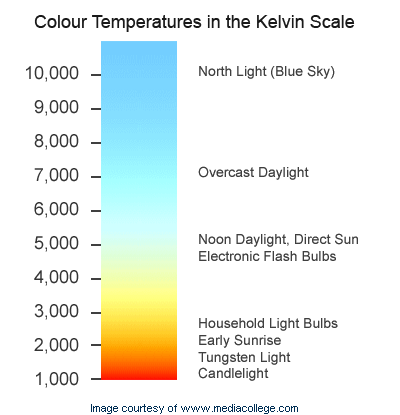Colour Temperature Chart
Colour temperature is a standard method of describing colours for use in a range of situations and with different equipment. Colour temperatures are normally expressed in units called kelvins (K). Note that the term degrees kelvin is often used but is not technically correct (see below).

Technically speaking...
Colour temperature means the temperature of an ideal black body radiator at which the colour of the light source and the black body are identical. (A black body is a theoretical radiator and absorber of energy at all electromagnetic wavelengths.)
Colour Temperature in Video
For video operations the relevant temperatures range from around 2,000K to 8,000K — these are common lighting conditions. In practical terms this usually means selecting lights, gels and filters which are most appropriate to the prevailing light or to create a particular colour effect. For example, a camera operator will select a "5600K filter" to use outside in the middle of a sunny day.
Terminology
- When referring to the unit kelvin, it is not capitalised unless it is the first word of a sentence. The plural is kelvins (e.g. "The light source is approximately 3200 kelvins").
- The symbol is a capital K (e.g. "The light source is approximately 3200K").
- When referring to the Kelvin scale, it is capitalised (e.g. "The Kelvin scale is named after William Thomson (1824 – 1907), also known as Lord Kelvin".
Degrees kelvin
According to the The International System of Units (SI), colour temperatures are stated in kelvins, not in degrees Kelvin. The "degrees" part of the name was made obsolete in 1967. However, the "degrees" reference has remained in common use in media industries.